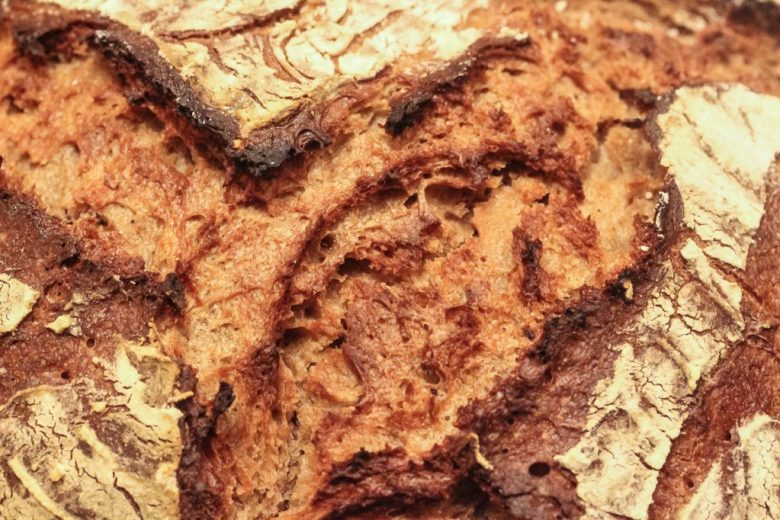Alpenlaib
Underripe or overripe sourdoughs almost always result in bread defects. It is important to only use sourdough with an optimal maturation. The following points should only be implemented individually, because several measures at the same time can lead to a strong change in the taste of the bread.
Sourdough is underripe (Sourness is too low):
- The amount of sourdough can be increased a bit for the recipe
- After preparing the dough, increase the dough maturation time (only partially recommended)
Sourdough is overripe (Sourness is too high):
- The amount of sourdough can be reduced a bit.
- Accelerate the processing of the dough, and ideally leave out the bulk fermentation so that further acidification by the lactic acid bacteria remains as low as possible.
- Overripe sourdough loses a lot of its leavening capacity on the proof. This should therefore be balanced out with yeast.
Level of acid and pH-value of sourdoughs:
The acidity and pH value of the sourdough are essential and important factors when making bread! A baker’s rule states that the pH value “bakes” and the acidity “tastes”
The sourness formed in the sourdough can be determined by the degree of acidity. The level of acidity gives an indication of the amount of rye flour to be soured. The following applies: the lower the acidity of the full sour, the more rye flour can be added to the bread dough in addition to the sourdough.
A highly soured flour content not only brings more acidity and flavorings to the dough, but also more swollen starch and degraded pentosans (slimy substances), which are essential for a soft crumb and a long shelf-life.
The acidity level is used to calculate the proportion of sourdough, which can be higher for multi-stage processes and for the Berliner quick-sour without producing a sour bread taste.
Guide values for the acidity level of different sourdough processes:
- For multi-stage sourdough processes = 12 – 16 acidity level
- For Detmold and salt-sour processes= 14-18 acidity level
- For Isenhäger bread fermentation = 30 acidity level
Sourdough proportion for various types of sourdough (guide values based on pure rye bread):
- BERLINER QUICK-SOUR
55% of the total rye flour amount - TWO- AND THREE STAGE PROCESSES
45-50% of the total rye flour amount - ONE STAGE PROCESS/ MONHEIM SALT-SOUR PROCESS
35-45% of the total rye flour amount - BREAD FERMENTATION
20% of the total rye flour amount
A high level of acidity should be aimed for if:
- The taste of the bread should be especially strong
- The flour is especially enzyme-rich (sprouted)
- Working with dark rye- and wheat flours
- Large loaves of bread are baked
- Working with very soft doughs
Recipe
For a dough weight of 1520g / 1 Alpine loaf
One-step sourdough
- 240g Rye flour Type-Alpenroggen
- 260g Water
- 5g Starter (2% of the total sourdough flour)
DT: 28°C Maturation time: 15-22 hours Hydration(TA): 208
VARIABLE:
Starter amount 5% of the total sourdough flour, Sourdough temperature 26°C
Starter amount 10% of the total sourdough flour, Sourdough temperature 23°C
Bread soaker
- 50g Leftover bread
- 100g Water 40°C
Soak for one hour before preparing the dough and then blend with an immersion blender.
Main dough
- 505g Mature sourdough
- 150g Bread soaker
- 360g Alpenroggen
- 100g Wheat flour Type 700
- 100g Wheat flour Type 1600
- 275g Water (45°C)
- 20g Salt
- 7g Yeast
- 3g Bread spice
Mixing time: 7 minutes slow/ knead 1 minute fast DT: 32°C Dough rest: 20-25 Minuten
Production
- Mix all the ingredients into a smooth dough
- After mixing, cover the dough and let it rise for 15 minutes.
- Shape the dough into a round loaf, and with the seam-side down place it in a proofing basket.
- Once ¾ proofed (40-45 minutes), slide the loaf into the oven.
- After half a minute, give strong steam and then let it out after about 4-5 minutes.
- The bread is baked at 250°C reduced to 200°C (reduce the oven temperature only after 10 minutes).
- Total baking time should not be less than 60 minutes.
Alpenroggen is a rye flour with a very high water absorption capacity. The taste is robust, the crumb is nicely compact and tender. For those that try to make this with the type 960 rye flour, the water amount in the sourdough needs to be reduced by 20g and by 30-40g in the main dough.









